Auke Visser's Famous T - Tankers Pages | home
"Sackett's Harbor", broken in two 1946
Some stories about this vessel, found on the World Wide Web.
Sailor saw sinking of the S.S. Sacketts Harbor
By DAN MCGREW
I joined the Merchant Marine on Oct. 4, 1943, at the age of 17.
I had my 18th birthday in Sydney, Australia, while aboard the tanker SS Sackett's Harbor. We had sailed from San Pedro, Calif., bound for Brisbane.
A submarine began pursuing us as we approached the east coast of Australia. We increased speed and passed through the south passage between Moreton Island and Russell Island. We were unable to make the turn to approach the Brisbane River and we ran aground in Moreton Bay, but the sub didn't follow.
The tanker's hull cracked, deck line to deck line, through No. 5 tank, losing its load of aviation fuel. We freed the ship on high tide, proceeded up river to Brisbane, discharged our cargo, and went south to Newcastle for repairs.
The shipyard welded the crack and we sailed to Sydney and then to Iran, where we loaded cargo and returned to Sydney.
I left the Sackett's Harbor on April 22, 1944, in San Pedro, but rejoined it on April 4, 1945, and sailed with a load of aviation fuel for the U.S. fleet.
In Leyte Harbor, Philippines, I found out that my older brother was anchored there and got a ride to his ship, the USS Achilles. He was a Pearl Harbor survivor and I had not seen him since early 1941.
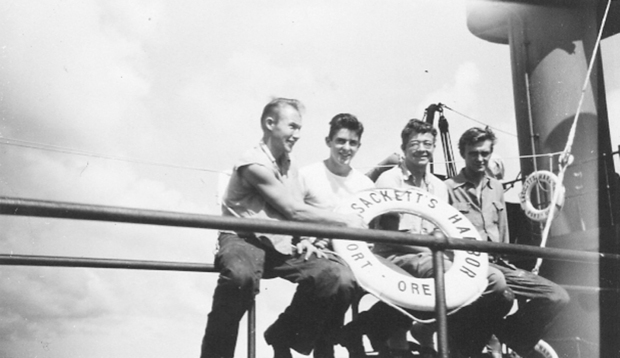 Bellingham resident Dan McGrew, third from the left, served in the Merchant Marine during World War II, including extended time aboard the tanker SS Sackett's Harbor.
My Dad, Francis Dale McFarland, served on the USS Sacketts Harbor when it broke in half. He left high school and enlisted in the Merchant Marine at the age of 17 in 1944. He went by the name dale but said the crew called him "the kid". I believe he is the man on the far right in the picture of the four men by the railing. He passed away March 17th, 2015 and was buried with Military Honors.
COURTESY — FOR THE BELLINGHAM HERALD.
The war ended while I was aboard the Sackett's Harbor. On March 1, 1946, the vessel broke in half off of Adak, Alaska. It broke at the No. 5 tank, the exact crack we had in Australia in 1943.
The forward half, with 10 men aboard, drifted away from the stern section. The radio was on the forward half and the men there managed to get it working and called for help. The frigate USS Orlando went to their assistance.
We were found five days later by a British cargo ship, and the Orlando brought the crew from the bow to us. The Orlando returned to the bow and found it capsized, with only the point of the bow above water. They sank the bow with cannon fire.
We sailed the stern section to Adak, where the crew was removed and sent home. Four of us remained aboard until July, when the section was towed to Anchorage, where it provided electricity to the city for many years.
I continued going to sea until I retired Jan. 1, 1980, as chief engineer of the supertanker SS Kenai.
|
James Oliver Calton, Jr.
James O. Calton, Jr. enlisted in the Merchant Marines in December of 1943 at the age of 18. His older brother Joe had already enlisted in the Army. His father, James Oliver Calton, Sr. had served in the Signal Corps during WWI. Like most young men of the time, he was anxious to do his part. Jim served until 1946, finishing the fight begun by the Japanese in December of 1941.
During those three years he was assigned to a Liberty Ship (the SS Bret Harte), a Victory Ship (the El Salvadore Victory), and two T-2 Tankers (the SS Sacketts Harbor and the SS Montebello Hills).
He made all of the usual runs, including Oran, Africa where he had a special ring made to commemorate the event. His first service was aboard the SS Bret Harte. He was aboard on April 1, 1944 when the Bret Harte was part of convoy UGS-36. The convoy came under attack by a bunch of Do-217's for about 20 minutes. The SS Jared Ingersoll took a torpedo in the forward hold and was the only ship damaged. While serving on the Bret Harte, he had an imaginary dog named "Leroy". He was always feeding, petting and talking to his imaginary dog in an unsuccessful attempt to make the captain think he was nuts. On day the captain pulled him aside and said "Calton, I don't mind you having a pet on board, but the next time your dog craps in my quarters you're going to be in big trouble!"
But his most memorable experience was aboard the SS Sacketts Harbor. On March 1, 1946, while enroute between Yokosuka and Balboa and about 800 miles southwest of Adak in the Aleutian Islands, the ship was caught between two wave crests and simply broke in two. No enemy fire...the ship just broke. As he tells it, the night the ship broke, he heard a "big bump" and all of the lights went out. He was aft and went running down the catwalk towards the front of the ship when all of a sudden he "ran out of ship"!
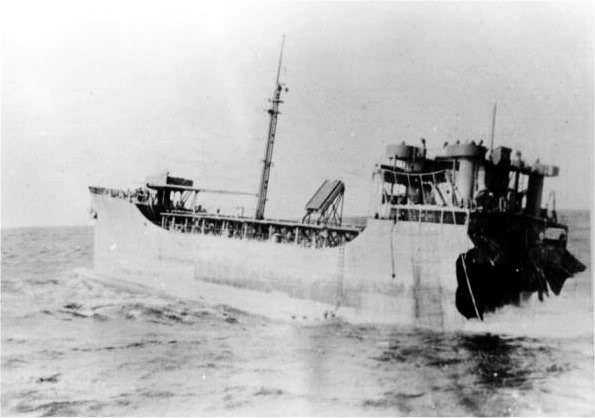 Sackett's Harbor Fore part
There were 10 men and 2 cats on the fore half, everyone else was in the aft half. The men on the fore half were concerned that if the cats got loose they could get lost or injured so they put them in a bureau drawer for safe keeping. Everyone assumed that since the aft half was heavier, it would sink first. To their amazement, the fore half began taking on water while the aft half remained afloat.
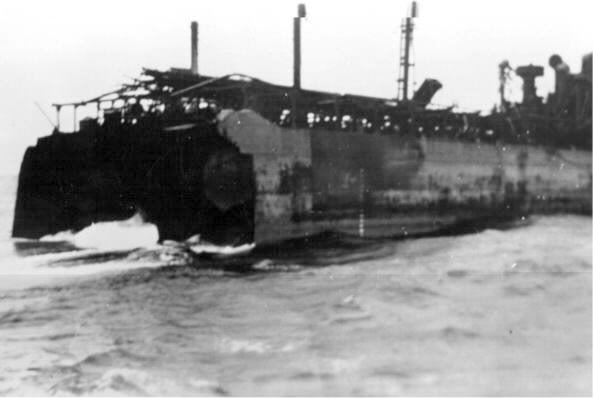 Sackett's Harbor after part
A Navy ship was dispatched to rescue them. A row boat was sent to pick up the men on the fore half and transfer them to the aft half. In the rush and confusion, the cats were forgotten and they became the only casualties. The rescue ship determined that the fore half would pose a hazard to navigation and their gunnery crew fired on it until it sank. The rescue ship attached a line to the aft half with the crew aboard and began to tow it to the nearest port in Alaska. The sea was very choppy and the Sacketts Harbor began to take on water. The Captain of the Sacketts Harbor requested the towing ship to either slow down or release them but the Captain of the towing ship refused.
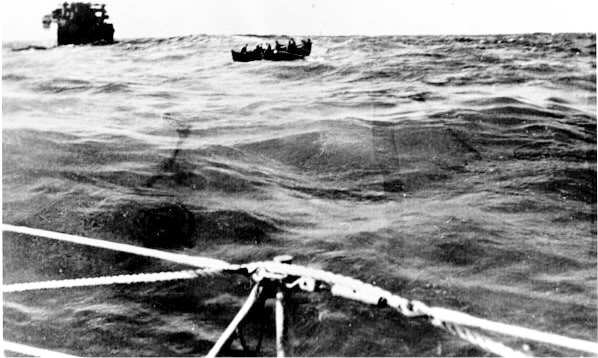 Sackett's Harbor evacuation from the fore part
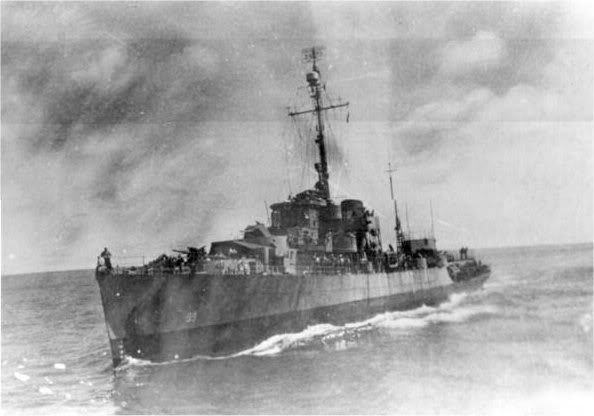 The rescue ship USS Orlando
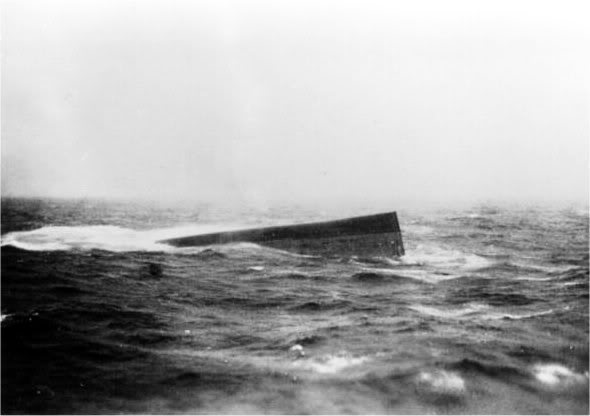 Sackett's Harbor fore part sinking, bottom up.
The Captain of the Sacketts Harbor then ordered his crew to cut the tow line. The Sacketts Harbor fired up it's engine, put it in reverse, and sailed into Adak under it's own power. It arrived in Adak on March 12 and was used as an electricity generating plant for a while. It was later towed to Anchorage. In 1957 a new fore half was built for the ship, it was re-christened and served as a wine tanker until at least 1970...first as the Angelo Petri and later as the Californian. She has since disappeared from the ship's registry and her ultimate fate is a mystery.
When the Korean Conflict came about, Jim tried to enlist in the Army, but they turned him down for being too old (25), having flat feet, and who knows what else. Two months later they drafted him! He served as an artillery observer with the 1st Cavalry.
He currently resides in Atchison, KS with his wife of over 25 years, Joan. He can be reached via his eldest son Joe at "jcalton@swbell.net".
|
The SS Sackett's Harbor was a T2 tanker that was built in August 1943. It served in the United States Merchant Marine during World War II. The ship was a namesake of Sackets Harbor, New York.
Sacketts Harbor survived the war basically unscathed but on 1 March 1946 it was sailing between Yokosuka and Balboa when it broke in half about 800 miles southwest of Adak, Alaska. The bow of the ship was sunk but the stern continued to float. The stern section was able to get to Adak under its own power. The only reported fatalities were two cats.
The ship was later towed to Anchorage, Alaska where it served as Anchorage's first major power source. The ship's electric drive supplied about 55% of Anchorage's electricity requirements from 1946 to 1955. In 1955, it was replaced by the Eklutna Hydroelectric Plant. The ship was given a new bow around 1957 and was rechristened as the SS Angelo Petri. It was fitted with stainless steel tanks and hauled wine for the Associated Vintners from Stockton, California through the Panama Canal to the East Coast.
Around 1970, the ship was sold and renamed the Californian. It has apparently been lost on records and its whereabouts are unknown.
References :
armed-guard.com
Anchorage Municipal Light and Power
westcoastwine.net
|
S.S.Angelo Petri...interesting story..
by TomHill » Tue Aug 08, 2006 1:05 pm
And here's what I dug up.
Just finished Thomas Pellechia's very interesting book "Wine..." on the history of the wine trade. A fascinating read ...highly recommended.
Thomas mentioned the sinking of the S.S. Angelo Petri off the coast near SanFrancisco in 1960. My immediate thought..is that wine still down there in DavyJones Locker and should I rent some scuba gear and go down and take some tasting notes on the wine??
Turns out, not sure Thomas' story of it's demise is quite correct. S.S. Angelo Petri was a tanker ship that was fitted with stainless steel tanks and owned by Louis Petri of Associated Vintners. From 1957, it hauled Petri's Escalon-
produced wine from Stockton thru the PanamaCanal to the EastCoast, where the wine was off-loaded and bottled at AV bottling lines in NewYork/Philadelphia/Boston. He was able to save 10 cents/btl and undercut the price of the up & coming Gallo Bros, who were strongly competing w/ Petri/AV to become #1.
On the return trip, the S.S.Angelo Petri filled those tanks with "edible oil" for sale in California (bringing coals to Newcastle?).
According to Leon Adams, the S.S.Angelo Petri plied its trade from 1957 until it was sold in 1972, the ship's name being changed about 1970 from S.S.Angelo Petri to S.S.California. It then apparently disappeared from the registry of ships shortly thereafter; its ultimate fate a mystery.
The S.S.Angelo Petri started life as the tanker Sacketts Harbor in 1943, built by Bethelem Steel (no relation to Jed Steele) and served in the Pacific thru the War,. On returning from Japan to Calif in 1946, in suddenly broke in half off the Aleutian Islands. Surprisingly, it was the fore half that sunk, the aft half remained afloat and with power. A rescue vessel started to tow it into harbor in Alaska at too high a speed and the captain was afeared of taking on more wa-ter. So he cut the tow line, fired up the engines, and proudly sailed into harbor backwards under its own power. This aft half served as a portable power supply in Alaska for a number of years.
Sometime afore 1957, the aft half was towed to a shipyard and refitted with a bow end (probably Louis Petri got a real deal on the aft half), stainless steel tanks installed, and then served a grand & glorious history until it was sold in 1972 and subsequently sold. In 1960, it lost power just off the entrance to SanFrancisco Bay and nearly foundered on the shoals. However, the CoastGuard Cutter Tanney rescued it and towed it into SanFrancisco safely. No record of its sinking then. Amazing what you can find with Google ("S. S. Angelo Petri wine"). And now you know the rest of the story.
Would be curious if anyone has any further info on S.S.Angelo Petri??
TomTomHill .
|